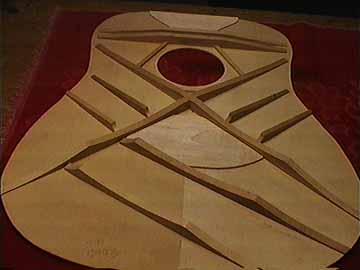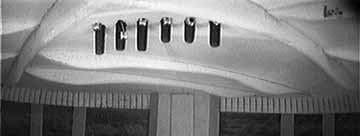Page 2 of 2
Just because you can predict the difference between Martin guitars
with and without scalloped braces, don't make the mistake of thinking that the same
reasoning applies to other makers. For example, a scalloped brace Taylor won't sound
the same as a scalloped brace Martin. The Taylor will sound like a Taylor (this is
a good thing) and the Martin will sound like a Martin (an equally good thing.)
How about straight brace Taylor guitars? Except for a signature model or two, Taylor
uses only scalloped braces on their dreadnoughts:

Notice that the shape of Taylor's braces are different than Martin's. This is the
sort of thing that gives instruments a "family" sound. If Taylor guitars
were built identically to Martin guitars, then they probably would sound the same,
too. So much for variety!
Straight brace guitars are not necessarily inferior. Some players prefer the sound
of Martin instruments with the straight braces. These pickers may refer to bassy
sounding scalloped models as being "tubby." Of course, the scalloped brace
Martin player might call the straight brace models "tight" or "tinny."
Some makers make both straight and scalloped models, and work sensitively to control
the sound of each.
Look at Santa Cruz Guitar Co's scalloped braces:

And now their straight braces:

Unlike the Martin system, Santa Cruz's is not simply a matter of taking the same
brace and scooping it out or not scooping it out. These straight, tapered braces
are completely different in their patterns of flexibility. The differences in tone
are far more subtle than between Martin's straight and scalloped braces.
Yes, you can "scallop" the braces of a guitar after it is made. We used
to do that in the days when you couldn't buy good new lightly braced guitars. Now,
however, there is an unlimited variety of great new instruments available, and we
really just don't do that any more. Better to upgrade to a significantly better sounding
guitar than just to modify and hope for improvement.
Here is a view of the inside of a 1957 Martin D-28. The top braces have been modified
by working through the soundhole. This is a pretty good job, and although the braces
don't look identical to original Martin braces from the 1940s, they bear a fair resemblance
to the older style:

When its owner bought this D-28 new in 1957, he elected to have the braces "scalloped"
for better bass response. He still owns the guitar and is still pleased with his
decision. If he were to sell the guitar in today's market, the modification would
result in a significantly lower selling price.
In case you might be wondering about the longevity of a modified guitar, let me assure
you that the top of this guitar looks as healthy as any I've seen. There is absolutely
no sign of deformation of the top after 30 years!
1
2
Back to Index Page